Nikon Nikkor AF-S 24-85 mm f/3.5-4.5G ED VR
3. Build quality and image stabilization
The fact that there are no competitors from Sigma, Tamron and Tokina is strange, though. 24-85 or 24-105 mm class lenses with f/2.8-4.0. f/3.5-4.5 or fixed f/4.0 aperture ranges and a great price/quality ratio would be a perfect offer for amateur photographers which don’t earn money while taking photos but might need a universal “zoom” for full frame. Meanwhile all Sigma and Tamron could offer are quite old 24-135 mm constructions which, nowadays, are not popular at all as they can’t impress with their optical properties.
Let’s return to the Nikkor 24-85 mm. In the photo below it is presented next to the professional Nikkor AF-S 24-70 mm f/2.8 and the Sigma 1.4/30 for smaller detectors. You can notice at once how handy the Nikkor 24-85 mm VR is especially if compared to its professional cousin.
Please Support UsIf you enjoy our reviews and articles, and you want us to continue our work please, support our website by donating through PayPal. The funds are going to be used for paying our editorial team, renting servers, and equipping our testing studio; only that way we will be able to continue providing you interesting content for free. |
- - - - - - - - - - - - - - - - - - - - - - - - - - - - - - - - - - - - - - - - - - - - - - - -
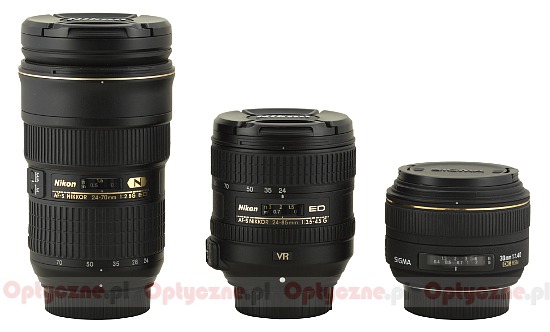 |
The tested lens starts with a metal mount which surrounds contacts and a rear element, 23 mm in diameter. At the shortest focal length and in a folded position that element is situated almost exactly on the level of the contacts. On passing to the maximum focal length the rear element hides about 2 cm inside, revealing the inner part of the tube. Its close inspection shows that its blackening is mediocre; you can also see some electronic and mechanical parts. A fully sealed, and perfectly blackened lens? Dream on.
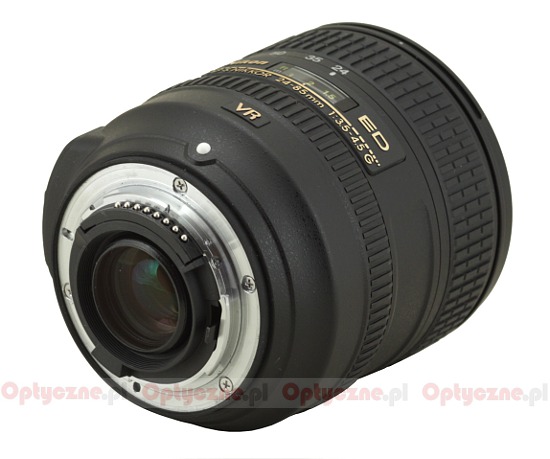 |
The outer part of the proper barrel is made of plastics. Immediately after the mount you can see a white dot which makes the alignment with a camera easier. Above the dot there are VR letters meaning an optical image stabilization system was used. On the left there are two switches: the first one, marked as M/A-M, is used to choose the focusing mechanism mode; the second one – VR ON/OFF – controls the optical stabilization.
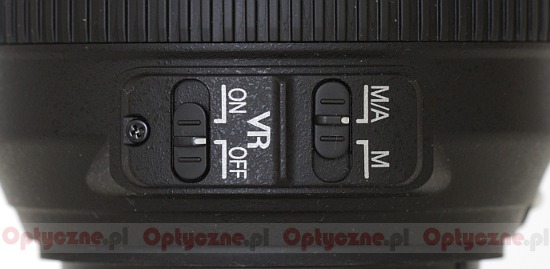 |
The next element is a ribbed, 8 mm wide manual focus ring. It has some slack when you start turning it – an annoying thing often met in Nikkors from this price segment. As soon as you shift the ring to one side you can notice how the distance scale and focus change. If you want to change the direction the ring moves but not producing any effect for about 3 mm (it corresponds to shifting the ring by one full ribbing) – neither the focus nor the distance scale change their positions. As I mentioned this flaw is simply inveterate in Nikkors of this class. If you add to it small dimensions of the ring it turns out the functionality of such a solution is very limited. The policy of the company might be questioned here as they cannot guarantee a fully functional manual focus ring in a device costing as much as 2,500 PLN.
It’s also worth mentioning that running through the whole scale takes a turn through 135 degrees - not bad for an amateur lens with an autofocus motor.
Behind the manual focus ring you can find a plate with the name and parameters of the lens which surrounds a distance scale behind a window. The scale is clear, expressed in feet and meters. On the other side of the lens there is an inscription “Nikon SWM VR ED IF Aspherical φ72” and information that the lens was made in China.
The next element is a quite big (23 mm wide) ribbed zoom ring with markings at 24, 35, 50, 70 and 85 mm. It moves evenly but you can feel a noticeable resistance in the 24-35 mm range; the resistance decreases at longer focal lengths.
The front element extends on a telescopic tube made of plastics - the tube doesn’t move sideways, though and looks quite solid. After the extension the lens increases its dimensions by 32 mm.
The front element itself is 60 mm in diameter and surrounded by a non-rotating filter thread, 72 mm in diameter, and a hood mount.
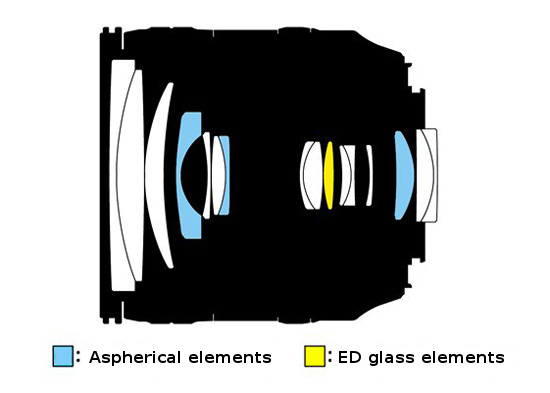 |
When it comes to the optical construction you deal here with 16 elements positioned in 11 groups. One ED low dispersion glass element was used and three aspherical ones as well. Inside you can also find an aperture with seven diaphragm blades, which can be closed to f/22-f/29, depending on the focal length.
Buyers get both caps, a petal-shaped hood and a soft pouch.
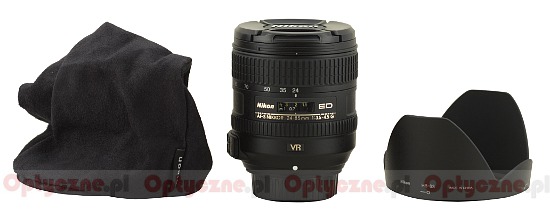 |
Optical stabilization
The producer emphasizes the fact that the lens is equipped with a VR II optical stabilization system which efficiency is supposed to be 4 EV. We decided to check that claim. In order to do that we chose 85 mm focal length and took several dozen photos at every exposure time ranging from 1/100 to 1/2 of a second with the stabilization switched on and off. Then we determined the percentage of blurred photos and presented it as a function graph, depending on the exposure time expressed in EV (and 0 EV was an equivalent of 1/80 of a second). The appropriate graph can be seen below.
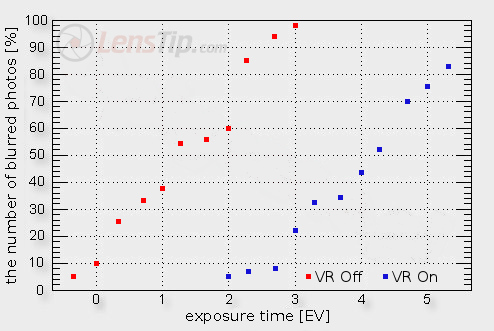
As you can notice the maximum distance between those curves amounts to 3 EV and so we assess the efficiency of the Nikkor’s 24-85 mm VR stabilization. It is short of those declared 4 EV but still it remains fully satisfying for such a range of focal lengths.






